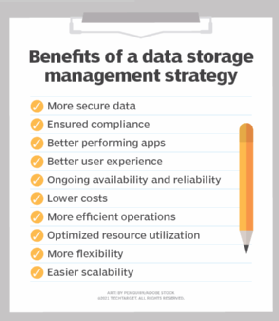Data storage management advantages and challenges explained (original) (raw)
Although establishing a data storage management strategy can be difficult, with increasingly distributed and complex systems, it offers several benefits to the organization.
Organizations are facing unprecedented challenges storing and managing data. Not only must they handle greater amounts of data, but they must also work with different types of data, much of it unstructured. At the same time, workloads have become more complex and varied and are often distributed across multiple geographic regions.
Workers, too, are more distributed -- many of them work from home, especially since the onset of COVID-19. Organizations must also contend with a growing number of cyber attacks, which are more aggressive and sophisticated, while complying with an assortment of regulations that govern data management. More than ever, IT teams must implement effective storage management strategies to address these challenges as efficiently and securely as possible.
Why is data storage management important?
A successful storage management strategy ensures data is available to users and applications when they need it. Storage management, however, isn't one size fits all, and each organization must determine what it takes to meet its own performance requirements and capacity demands, while staying flexible enough to accommodate changing circumstances. An effective storage management strategy helps with the following.
Meet security and compliance requirements
Organizations are under great pressure to ensure their data is protected against security threats and they adhere to applicable regulations, especially with the advent of cloud storage and other cloud services. A data breach can disrupt business and result in costly lawsuits and tarnished reputations, sometimes beyond repair. Even if data hasn't been compromised, an organization might still be subject to hefty fines if not in compliance with applicable regulations. Effective storage management is essential to ensuring data is continuously protected and adheres to governing laws. Even one or two misplaced files can put an entire organization and its customers at risk.
Maximize performance
Many factors go into an app's performance. One of the most important factors is the storage systems that support the app. IT teams must ensure their storage devices can continuously deliver the necessary performance, regardless of the storage location. Not only does this require the right devices, but those devices must also be properly maintained and periodically upgraded to meet ongoing performance needs. To complicate matters, most IT teams must support multiple apps and multiple storage systems, each requiring careful administration. Only with an effective storage management strategy in place can an organization make certain that all their storage systems continuously deliver the performance necessary to meet fluctuating user and application demands.
Ensure availability and reliability
As with performance, IT teams must ensure the ongoing availability and reliability of their storage systems, and the only way to do this effectively is to put comprehensive storage management strategy into place. A management strategy makes certain that the storage systems are properly deployed and maintained and that the necessary disaster recovery mechanisms -- such as replication, backups or snapshots -- are in place to keep disruptions to a minimum should disaster occur. An effective strategy also considers the need to support distributed apps and users. For example, IT might need to balance loads across multiple data stores or locations to minimize workload disruptions.
Ensure effective resource management
A storage management strategy makes it easier for administrators to plan and maintain their storage systems. With the right strategy, they can provide their apps and users with the storage capacity they need, while avoiding unused or overprovisioned storage. In this way, they can better utilize storage resources and reduce the costs and complexities that go with managing unnecessary storage. They can also reduce the amount of power and cooling needed to support their storage systems. Storage management can even help admins better plan the virtual memory used by OSes. Effective storage management also helps IT teams better prepare for scaling their systems to accommodate changing workloads and address compatibility and integration issues early on, rather than trying to piece components together on an ad hoc basis.
Streamline system administration
Managing storage can be a significant undertaking, especially as data amounts increase and storage platforms become more complex. A storage management strategy can help IT teams centralize storage administration and make it easier to maintain multiple storage systems regardless of the types of workloads they support. Such a strategy can also help IT incorporate automation into their workflows, deploy technologies such as software-defined storage and enhance their operations through such mechanisms as dynamic tiering or AI-based analytics.
Reduce costs
IT teams are looking for ways to reduce storage costs, especially with the staggering rate of data growth. A management strategy can help IT better utilize storage resources and streamline storage management operations, both of which can reduce costs. In addition, a management strategy can lead to better performance, availability and reliability, increasing worker productivity and customer satisfaction and, in turn, improving the bottom line. Storage management also provides better visibility into the data, enabling organizations to more easily extract value from the data.
What are the benefits of data storage management?
Data storage management can offer numerous advantages, if the strategy has been carefully planned and implemented. For example:
- Data is more secure because measures are taken to mitigate threats and provide ongoing visibility into data access patterns and potential risks.
- Compliance is easier to achieve because mechanisms are implemented to ensure data and storage management complies with applicable regulations and can meet auditing requirements.
- Storage systems deliver the performance necessary to support current workloads, while accommodating fluctuating requirements, resulting in better performing apps and a better user experience.
- Systems, processes and data protections are put into place to ensure ongoing availability and reliability, while providing disaster recovery if needed, resulting in greater user productivity and customer satisfaction.
- Storage devices provide the capacity necessary to meet current and future workloads, while accommodating different types of data, without overprovisioning storage hardware.
- Storage systems are flexible enough to scale as demand fluctuates, while being able to adapt to changing requirements and accommodate new storage technology.

- Storage systems are easier to manage and monitor, and deploying storage devices is faster, often without the compatibility and integration issues that come with siloed or piecemealed storage systems.
- A greater reliance on automation reduces the number of repetitive manual tasks, while better optimizing storage resources and ensuring greater storage security.
- Effective storage management can lead to lower costs because operations are more efficient, storage resources are better utilized, security risks are lower, and compliance is easier to achieve, helping avoid costly penalties.
What are the challenges of data storage management?
Although a storage management strategy offers several benefits, implementing it can be a challenge. Some of the most common issues include:
- Distributed systems. Organizations have always struggled against storage siloes, which can lead to underutilized resources and fuel conflicting interests among teams. But today's distributed environments result in even greater challenges, as organizations implement multi-cloud and hybrid cloud environments and move apps and data to the edge. Storage systems that are spread across multiple storage locations add deployment and management complexities and can increase costs and affect performance.
- System complexity. The storage industry offers more options than ever for storing data. IT teams might need to manage SAN and NAS systems, as well as cloud services, many of which use object storage. Teams might also manage tape drives, HDDs, SSDs or even storage class memory. At the same time, their workloads might be virtualized, containerized or running on bare metal. Some teams also work with converged, hyper-converged or composable infrastructure alongside traditional storage systems. The more device types and technologies that an organization uses, the greater the complexity and management overhead, especially as compatibility and integration issues increase.
- Remote and distributed workloads. More than ever, IT teams must contend with distributed and remote workers, as well as apps running across multiple locations. Admins must ensure apps and users can access the data they need, no matter where they're located or when they work. Often, this means implementing replication, mirroring or other strategies to keep data in sync and continuously available, complicating storage management even more.
- Implementing new technologies. Organizations implement new storage and data technologies to improve application performance and reliability. Newer technologies can also help streamline operations and shorten app development and deployment lifecycles. But deploying these technologies takes time and personnel and often requires specialized training and education. The technologies might also require hiring new personnel or bringing in outside experts, which can increase costs and delay implementation.
- Data management. Data management often falls under the purview of storage management, requiring IT teams to consider several important factors. For example, they might need to implement systems for archiving and deleting data or make data available for analytics or business intelligence. Regardless of the circumstances, they must deploy and maintain adequate protections that ensure the data is always available and safeguarded against internal and external threats, while complying with applicable regulations. All these tasks take trained personnel who have the time and ability to orchestrate and carry out complex operations.
Despite these challenges, an effective storage management strategy is essential to meeting today's storage and data demands, and those demands will only increase as more data is generated, workloads become more complex and technologies continue to evolve.
Storage architects, enterprise storage admins and other storage professionals require storage management strategies that meet these challenges head on and enable them to store and manage data in a way that can accommodate current and future requirements, while ensuring the data's integrity, security and ongoing availability.
Next Steps
SSD vs. SSHD vs. HDD: Which one is best?
10 data storage issues and how to overcome them
Immutable storage: What it is, why it's used and how it works
Tips to reduce the environmental impact of data storage
How to prepare a data storage budget, with free template
Dig Deeper on Storage management and analytics
-
 Flash, AI and cloud: 3 IT takeaways from Pure Accelerate
Flash, AI and cloud: 3 IT takeaways from Pure Accelerate  By: Scott Sinclair
By: Scott Sinclair -
 Hybrid multicloud storage: Pros, cons and key workloads By: Stephen Pritchard
Hybrid multicloud storage: Pros, cons and key workloads By: Stephen Pritchard - Hybrid cloud storage vs on-premise: What data goes where? By: Stephen Pritchard
-
 On-premises storage, infrastructure evolves to keep pace with AI
On-premises storage, infrastructure evolves to keep pace with AI  By: Scott Sinclair
By: Scott Sinclair